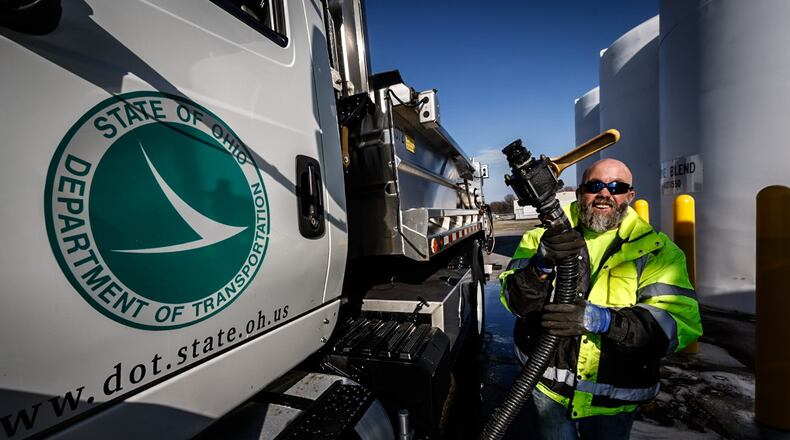Clark County starts each season with about 5,600 tons of salt on hand. County Engineer John Burr said recent milder winters have allowed for significant rollover and less new purchasing the past two years.
“We have carried over approximately 3,000 to 4,000 tons each year,” Burr said.
Springboro City Manager Chris Pozzuto said the city spent $54,760 on salt in 2023, which he called comparable to the previous three years. Pozzuto said recent years’ mild winters have not changed how the city prepares for the season.
“Every winter season is different and we have to be prepared for the worst possible scenario,” he said.
Major snowstorms affect all drivers’ safety and ability to get around, but they can also put a serious dent in local governments’ budgets. Repeated snowstorms in 2014 turned that year into a “million-dollar winter” for the city of Dayton. Salt costs that fluctuate from year-to-year are one factor, and plow-driver overtime is another big one.
The city of Hamilton typically carries over at least 2,000 tons each year regardless of weather conditions, according to spokesperson Maddie Watkins. This year, the city spent $120,124 on salt, up from $115,416 last year, but down from $187,373 in 2021.
The price per ton of salt varied between these three years, as well, with Watkins saying the city purchased this year’s supply at a price of 90.66 per ton, up from 62.32 in 2022. The price in 2024 is 97.66 per ton, she said.
Salt and de-icer can be tough to budget for, as no one can accurately predict the weather months in advance. In 2023, Montgomery County spent $371,529 on salt to combat icy roads. Engineer Paul Gruner said the county begins each winter season with about 10,000 tons of salt on hand. In Butler County, salt storage totals begin at 13,000 tons each winter.
At the state level, the Ohio Department of Transportation currently had about 757,810 tons of salt on hand to begin the season, according to spokesperson Matt Bruning.
“We always carry any unused salt over from winter to winter, so the years following mild winters mean we don’t have to purchase as much salt,” Bruning said. “We put contracts out (each year) for competitive bidding by county. The only difference would be that after a harsher winter, we might do a summer bid and a winter bid.”
Credit: JIM NOELKER
Credit: JIM NOELKER
Have de-icing techniques evolved with the weather?
For years, Montgomery County road crews have used a brine/beet juice mix to prep roads for icy conditions. Gruner said the county will begin to use more of this mixture moving forward.
“Our increased use is not totally the result of changes in weather, but our ability to carry more mix,” Gruner said. “For the first time this snow season, all 20 of our plow trucks have 240 gallon tanks, which is an upgrade from 55 gallons.”
Gruner also said the beet juice allows for less salt usage, because it naturally makes the salt more effective, especially at colder temperatures.
Typically, salt becomes less effective below 15 degrees, according to data shared on Butler County’s website. Brine is more effective at warmer temperatures and is especially useful as a pre-treatment.
The Dayton area had only 0.8 inches of snow in November and December combined, according to the National Weather Service, tied for the fifth-lowest total in the past 75 years. The final two months of 2021 were the same.
Gruner said even when overall snow totals for a year are low, a winter can still be busy and expensive if there are a large number of small storms, with depths of just one to two inches.
“That still requires the spreading of salt,” he said, adding that an increase in rainy conditions during the cold season is also having an effect. “We seem to be having more ice storms and storms beginning with rain or changing from snow to rain and back to snow (and) the rain washes off the salt.”
Bruning said ODOT has changed its approach to road salting in recent years, as well, aiming for better effectiveness.
“We have started using more and more of the brine we make in-house,” he said. “The solution, made up of 23% salt and 77% tap water, allows salt to be applied more precisely and efficiently compared to traditional rock salt, which tends to scatter or get plowed off to the side of the roadway.”
Credit: Marshall Gorby
Credit: Marshall Gorby
Even during milder winters, a single 24-hour event can require significant response from road crews. In Butler County, one such winter storm could require the use of four truckloads of salt/brine materials, totaling $78,720.
Joey Shope, public services superintendent for Beavercreek, said while the city experienced fewer snow events last year, there were more conditions requiring road salting, which resulted in “consistent salt usage.”
Overall, Shope said, the city’s goal is to provide safe travel conditions for drivers on an “environmentally and fiscally responsible” basis. And the city’s road division aims to be prepared for any number of scenarios each winter, from freezing temperatures and ice to conditions precipitated by slightly warmer winter weather.
Cities will need to be prepared this weekend — in the past two days, various forecast models have called for anywhere from 1 inch to 6 inches of snow in the Miami Valley on Saturday.
“Winter weather can vary, so this division’s plan is designed to be flexible,” Shope said.
About the Author



